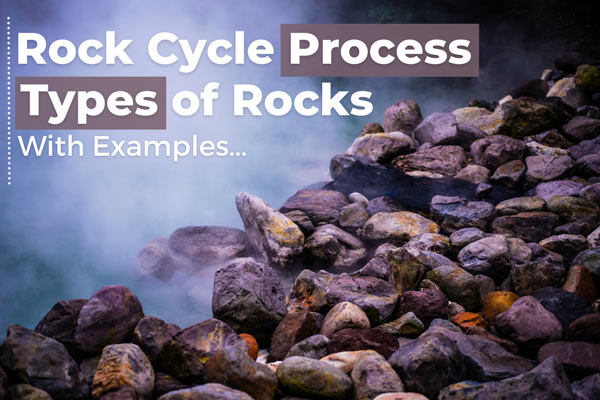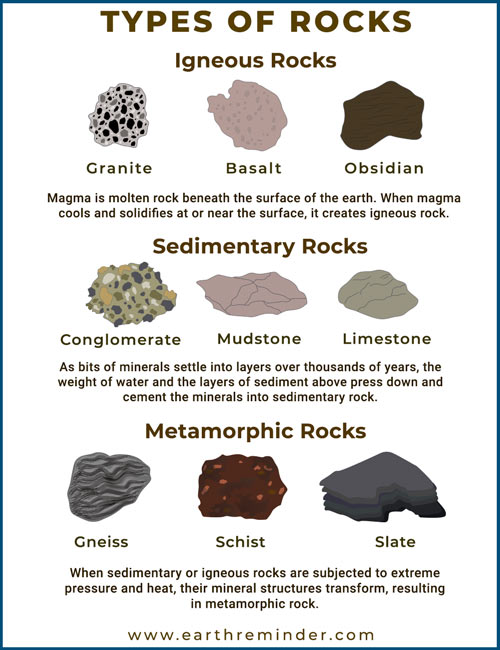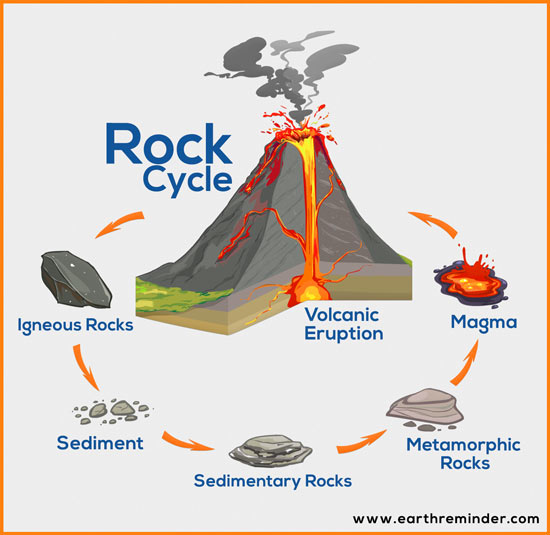Process of Rock Cycle – Main Types of Rocks with Examples
What Do You Mean By Rock Cycle & What Types of Rocks Does Rock Cycle Create?
Rocks are everywhere. From mountains to plains and riverbeds, rocks cover almost every surface of the Earth. But not all rocks are the same. Some are very hard, some shiny, some porous. All this indicates that rocks have different compositions. The big question is, where do they come from, and how do rocks form?
Rocks form through the rock cycle. It’s a process that leads to the transformation of one rock to another. The Rock cycle creates different types of rocks. Several factors contribute to the rock cycle, which we will understand one by one in detail. Let’s hop on!
Table of Contents
- 1 What Are Rocks?
- 2 Main Types of Rocks with Examples
- 3 What is the Rock Cycle?
- 4 What Are the Factors That Influence the Rock Cycle?
- 5 Different Phases of Rock Cycle
- 6 Stages Of the Rock Cycle
- 7 What Drives the Rock Cycle?
- 8 Importance of Rock Cycle
- 9 Conclusion
What Are Rocks?
The Rock cycle involves rocks; therefore, it’s essential to understand what rocks are? By definition, rocks are naturally occurring solid masses composed of minerals and minerals-like substances.
Note: You should note that rocks differ from minerals. A mineral is a naturally occurring element or chemical compound that goes into the formation of rocks. Rock is not a mineral, but every rock is made up of one or more minerals.
Depending upon their formation, rocks can be of mainly three types:
- Igneous Rocks
- Sedimentary Rocks
- Metamorphic Rocks
Main Types of Rocks with Examples
Igneous Rocks
Igneous rocks are formed when hot liquid magma cools down and becomes solid. It’s the most common type of rock found on Earth.
The term igneous comes from the Latin word ignis, which means ‘come from fire.’ As the origin of these rocks is from scorching magma, they are called igneous rocks.
Types of Igneous Rocks
There are two types of igneous rocks, and their formation depends on where the cooling of magma takes place.
- Intrusive Igneous Rocks
- Extrusive Igneous Rocks
Intrusive Igneous Rocks
If the cooling of magma happens inside the Earth’s crust, it cools down very slowly and forms hard rocks. During the slow cooling, large crystals easily visible to the naked eye are formed. Rocks formed due to the slow cooling of magma inside the Earth’s crust are called intrusive igneous rocks or plutonic igneous rocks.
Examples of intrusive igneous rocks: Granite, Diorite, Gabbro.
Extrusive Igneous Rocks
Magma sometimes finds its way to the surface of Earth and violently erupts from the faults on Earth’s surface. When magma reaches out to the surface in the form of lava, it cools down rapidly.
The rapid cooling of magma on the Earth’s surface forms extrusive igneous rocks. The resulting rocks have a fine texture and very tiny crystals.
Occasionally extrusive igneous rocks have small holes on their surface. These holes are formed due to gas escaping from the magma during the cooling process.
Examples of extrusive igneous rocks: Pumice, Obsidian, Basalt.
Sedimentary Rocks
When deposits of sediments are compressed together, they form sedimentary rocks.
Water, erosion, and weathering break down rocks and minerals into tiny sediments, which over time are deposited in sedimentary basins.
These sediments are compressed under pressure and form sedimentary rocks. The example includes sandstone and limestone.
Sedimentary rocks often include layers, also known as strata. Therefore sedimentary rocks are also called stratified rocks.
According to their formation process, there are two types of sedimentary rocks:
- Detrital Sedimentary Rocks
- Chemical Sedimentary Rocks
Detrital Sedimentary Rocks
Detrital sedimentary rocks form from detritus or debris. The debris of rock particles comes from the weathering and erosion of rocks. These sedimentary rocks often form underwater, where the debris is transported and accumulated and over time compacts into rocks.
Detrital rocks can further be classified into;
- Organic Detrital Rocks
- Inorganic Detrital Rocks
Organic Detrital Rocks
Organic detrital rocks are mainly composed of organic material. When plants and animals decay, they leave behind organic materials. These organic materials are transported and accumulated by wind and water, and over time they compress and form organic detrital rocks.
Example of organic detrital rocks: Coal, Some Dolomites
Inorganic Detrital Rocks
Inorganic detrital rocks do not consist of any living material. Instead, they are formed from the fragments of other rocks (metamorphic, igneous). Inorganic detrital sedimentary rocks are also known as clastic sedimentary rocks.
Examples of inorganic detrital rocks: Sandstone, Conglomerate.
Chemical Sedimentary Rocks
Chemical sedimentary rocks also form due to the compaction and cementation of sediments. However, the sediments come from the precipitation of substances in the water. For example, the precipitation of calcium carbonate from seawater forms limestone.
Examples of chemical sedimentary rocks: Limestone, Iron ore, and Some Dolomites.
Metamorphic Rocks
Metamorphic Rocks form when one rock changes due to heat, temperature, and pressure and transforms into another rock. The process is called ‘metamorphism,’ which simply denotes change from one thing to another.
Metamorphic rocks involve specific conditions of high pressure and temperature, often found deep inside Earth. Moreover, the rock undergoing metamorphosis should not melt, or it will become magma, not metamorphic rock.
Depending upon the process involved, metamorphic rocks can be of two types;
- Non-foliated metamorphic rocks
- Foliated metamorphic rocks
Foliation is a process when rocks consist of consecutive thin layers. Foliation comes from the Latin word folium, which means ‘leaf.’
Non-foliated Metamorphic Rocks
These types of metamorphic rocks form under the influence of directed pressure, often near the surface. Such types of rocks usually form due to regional or contact metamorphism. Apparently, these rocks lack the foliated structure, hence the name. Examples include greenstone and marble.
Foliated Metamorphic Rocks
Foliated metamorphic rocks are formed due to very high direct sheer pressure and temperature. The recrystallization process results in the formation of consecutive layers or sheets. Examples include gneiss, slate, schist, and phyllite.
Types of Metamorphosis
Metamorphosis differs depending upon the condition and the place where the process occurs. There are mainly five types of metamorphosis;
- Regional Metamorphosis
- Contact Metamorphosis
- Dynamic Metamorphosis
- Hydrothermal Metamorphosis
- Burial Metamorphosis
- Regional Metamorphosis
When the entire rock body in an area undergoes metamorphism in the influence of heat and pressure, the process is known as regional metamorphism.
The process results in the rearrangement and recrystallization of minerals and gives rise to metamorphic rocks.
Contact Metamorphosis
When rocks undergo metamorphosis due to their proximity to a heat source, such a phenomenon is known as contact metamorphism. The high temperature is often attributed to rising magma that heats rocks in contact.
Rocks formed due to contact metamorphism are usually found on either side of an area of intrusive igneous rocks.
Dynamic Metamorphosis
Dynamic metamorphism does not involve very high temperatures. Instead, the changes attributed to dynamic metamorphosis result from very high shear stress.
It often occurs near the faults and is generally limited to a narrow region. This type of metamorphosis is also known as cataclasis.
Hydrothermal Metamorphosis
Hydrothermal metamorphism occurs when rocks interact with a high-temperature fluid. The high-temperature fluid could result from magma or from very hot ground or ocean water.
Burial Metamorphosis
Burial metamorphosis occurs to the sediments buried deep inside the ground, beyond the boundary where sedimentary rocks form.
The heat and pressure cause recrystallization and form new minerals. However, the temperature and pressure involved are generally low.
Example of Metamorphic Rocks: Phyllite, Schist, Gneiss, Quartzite, Marble.
What is the Rock Cycle?
The Rock cycle is the slow, continuous geological process through which the three main types of rocks on Earth form. Rock cycle explanation and diagram is given below;
- The rock cycle explains all the changes that rocks undergo over time.
- The Rock cycle is also known as the lithological cycle and denotes the relationship between the three basic types of rocks (Ingenious, Sedimentary, metamorphic)
- It’s a continuous process and never stops. Instead, different rocks slowly undergo changes and transform into other rocks.
- During the rock cycle, rocks formed deep underground and reached the surface. Then, undergo many changes due to geological activities and, over time, return to the ground below.
What Are the Factors That Influence the Rock Cycle?
The rocks cycle is the result of Earth’s geological activities. Therefore, rock cycles depend upon two essential factors:
- External Factor
- Internal Factor
External Factor
External factors are the external geological processes that act on the planet’s surface. These are agents such as wind, rain, rivers, and the sea. These agents continuously affect rocks and constantly erode them.
Internal Factors
Internal Factors are the internal geological processes that act inside the Earth’s surface. These are the factors generated by the Earth’s internal energy.
For example, the intense pressure and heat melt down rocks to form magma.
The magma moves through volcanic processes, earthquakes, and tectonic movements. It eventually cools down and forms igneous rocks.
Different Phases of Rock Cycle
The Rock cycle is a continuous process that involves several phases. Each phase impacts rocks, drives them further down the cycle and changes their form.
The phases of the rock cycle include;
- Crystallization
- Erosion and sedimentation
- Lithification
- Metamorphism
Let’s discuss each phase of the rock cycle in detail;
Crystallization
- It occurs when magma cools down inside or the surface of the Earth and forms igneous rocks.
- Crystallization and the size of the crystal depend on the rate of cooling of magma.
- Slow cooling forms bigger crystals, while rapid cooling creates smaller rock crystals.
Erosion and sedimentation
- Rocks on the surface of Earth are constantly influenced by external geologic agents such as wind, water, and weather.
- These agents erode and wear down rocks into smaller pieces called sediments.
- These sediments are transferred through wind, water, and moving ice from one place to another.
- The sediment then clumps together to form sedimentary rocks.
Lithification
- Lithification is the process of compaction and cementation of loose sediments.
- It is the process that turns loose sediments deposited into sedimentary beds into solid rocks.
- Lithification solidifies sediments to form sedimentary rocks.
Metamorphism
- When the rocks inside the Earth’s crust are exposed to intense heat and pressure, the mineral composition of these rocks changes.
- The rock metamorphoses into another rock with a different texture and mineral composition.
- The process is known as metamorphism and the rocks thus formed are called metamorphic rocks.
Stages Of the Rock Cycle
Similar to different phases, the rock cycle also consists of various stages. Each stage involved leads to the formation of different rocks.
Formation of igneous rock – Transition of magma to igneous rocks
- Although the rock cycle is continuous, it mostly starts with magma.
- The cooling of magma gave rise to igneous rocks. When magma cools down in the Earth’s interior, it forms intrusive igneous rocks.
- However, if the cooling process occurs outside the Earth’s crust, the rocks formed are called extrusive or volcanic rocks.
The transition of ingenious rocks to sedimentary rocks
- Ingenious rocks on the surface break down under the effect of weather, erosion, wind, and water.
- The smaller sediments in the form of sand, pebbles, and gravel are deposited layer by layer onto each other.
- These layers, over time, solidify through compaction and cementation and form sedimentary rocks.
The transition of sedimentary rocks to metamorphic rocks
- The formation of metamorphic rocks involved high pressure and temperature. These conditions are found deep inside the Earth.
- Sedimentary rocks, over time, are pushed deep underground where they are subjected to intense heat and pressure.
- Some rocks melt and form magma, while others go through the process called metamorphism.
- Metamorphism changes the mineral composition inside the rocks as well as the texture. Over time, metamorphism turns the rock into metamorphic rocks.
The transition of ingenious rocks to metamorphic rocks
Metamorphic rocks can directly form from igneous rocks. Under the influence or exposure of heat and pressure, igneous rocks form inside the Earth’s crust. The intense conditions result in the metamorphosis and form metamorphic rocks.
What Drives the Rock Cycle?
The rock cycle occurs because Earth is a dynamic system, constantly undergoing numerous changes.
- The internal heat and gravitation cause the tectonic plates to move.
- Plates’ movement created fractures and faults, allowing magma to escape to the surface, cool down, and form igneous rocks.
- Tectonic plate interaction pushes rocks deep inside Earth to the surface. The process also helps form sediments, which eventually turn into sedimentary rocks.
- Plate interactions also create situations in which metamorphosis occurs. Metamorphosis leads to the formation of metamorphic rocks.
- Mountains formed through plate tectonics are the sources of glaciers and rivers. These agents combined with wind and rains erode and break rocks into sediments.
- Rivers and glaciers carry these sediments to sedimentary basins, where they lithify and form sedimentary rocks.
Importance of Rock Cycle
-
- The Rock cycle directly leads to the formation of soil. Without soil, life will not be possible on land.
- Rocks formed through the rock cycle are extensively used in construction—for example, marble, limestone, granite.
- Fossil fuels and radioactive elements, the backbone of our energy production, resulting from the rock cycle.
- The rock cycle helps scientists understand different aspects of Earth’s geology.
- Essential minerals, vital for human life form, thanks to the rock cycle.
Conclusion
Earth’s internal and external geological factors shape our planet. These agents, coupled with gravity, tectonic plates movements, and volcanic eruption lead to the formations of rocks that we see littered on Earth’s surface and create the process known as the rock cycle.
The Rock cycle creates rocks continuously and brings essential nutrients to the surface, making the soil fertile. Moreover, it also plays a critical role in understanding how our planets work and what forces derive their working mechanism.


